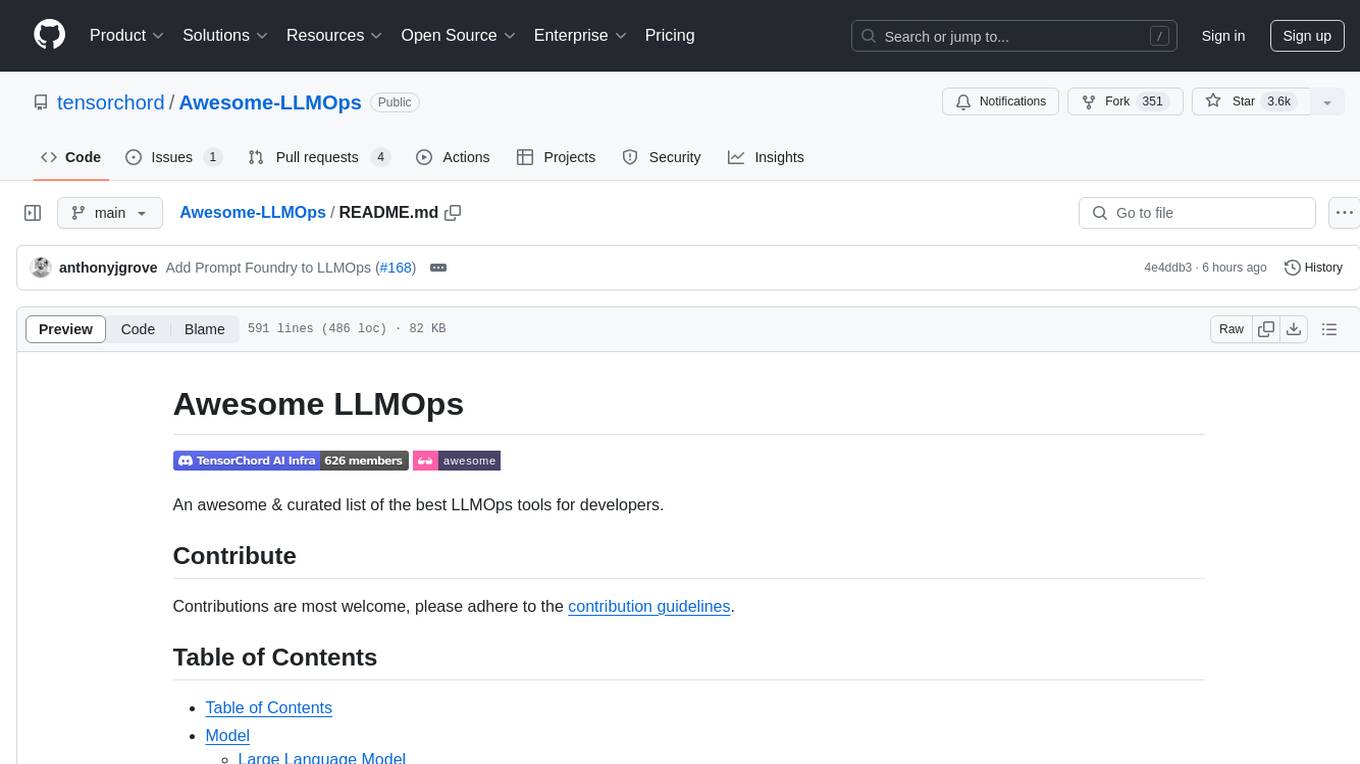
casibase
⚡️AI Cloud OS: Open-source enterprise-level AI knowledge base and MCP (model-context-protocol)/A2A (agent-to-agent) management platform with admin UI, user management and Single-Sign-On⚡️, supports ChatGPT, Claude, Llama, Ollama, HuggingFace, etc., chat bot demo: https://ai.casibase.com, admin UI demo: https://ai-admin.casibase.com
Stars: 4055
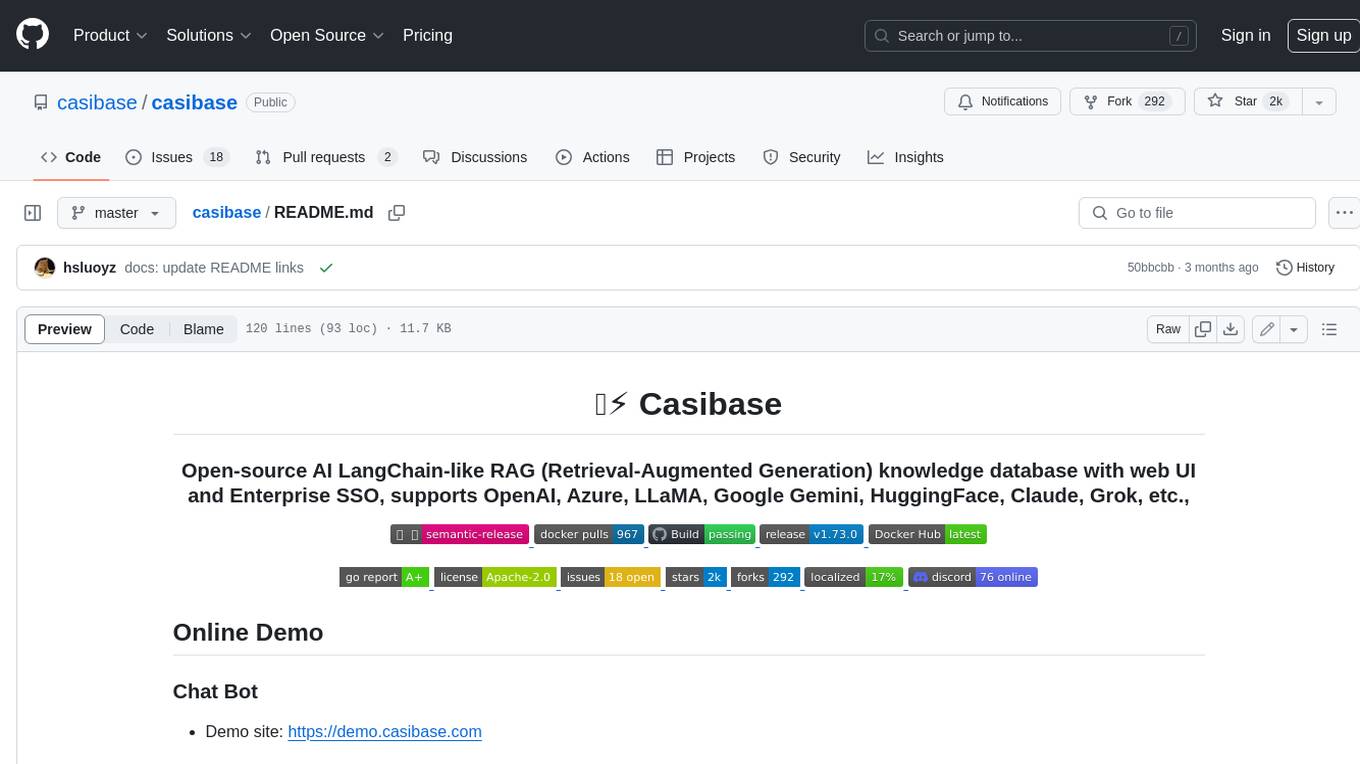
Casibase is an open-source AI LangChain-like RAG (Retrieval-Augmented Generation) knowledge database with web UI and Enterprise SSO, supports OpenAI, Azure, LLaMA, Google Gemini, HuggingFace, Claude, Grok, etc.
README:
AI Cloud OS: Open-source enterprise-level AI knowledge base and MCP (model-context-protocol)/A2A (agent-to-agent) management platform with admin UI, user management and Single-Sign-On⚡️, supports ChatGPT, Claude, Llama, Ollama, HuggingFace, etc.
- Chat bot: https://ai.casibase.com
- Admin UI: https://ai-admin.casibase.com
- Chat bot: https://demo.casibase.com
- Admin UI: https://demo-admin.casibase.com
Casibase contains 2 parts:
| Name | Description | Language |
|---|---|---|
| Frontend | User interface for Casibase | JavaScript + React |
| Backend | Server-side logic and API for Casibase | Golang + Beego + Python + Flask + MySQL |
Language Model
| Model | Sub Type | Link |
|---|---|---|
| OpenAI | dall-e-3, gpt-3.5-turbo-0125, gpt-3.5-turbo, gpt-3.5-turbo-1106, gpt-3.5-turbo-instruct, gpt-3.5-turbo-16k-0613, gpt-3.5-turbo-16k, gpt-4-0125-preview, gpt-4-1106-preview, gpt-4-turbo-preview, gpt-4-vision-preview, gpt-4-1106-vision-preview, gpt-4, gpt-4-0613, gpt-4-32k, gpt-4-32k-0613, gpt-4o, gpt-4o-2024-05-13, gpt-4o-mini, gpt-4o-mini-2024-07-18 | OpenAI |
| Claude | claude-2.0, claude-2.1, claude-instant-1.2, claude-3-sonnet-20240229, claude-3-opus-20240229, claude-3-haiku-20240307 | Claude |
| Local | custom-model | Local Computer |
| DeepSeek | deepseek-chat, deepseek-reasoner | DeepSeek |
| Azure | dall-e-3, gpt-3.5-turbo-0125, gpt-3.5-turbo, gpt-3.5-turbo-1106, gpt-3.5-turbo-instruct, gpt-3.5-turbo-16k-0613, gpt-3.5-turbo-16k, gpt-4-0125-preview, gpt-4-1106-preview, gpt-4-turbo-preview, gpt-4-vision-preview, gpt-4-1106-vision-preview, gpt-4, gpt-4-0613, gpt-4-32k, gpt-4-32k-0613, gpt-4o, gpt-4o-2024-05-13, gpt-4o-mini, gpt-4o-mini-2024-07-18 | Azure |
| Amazon Bedrock | claude, claude-instant, command, command-light, embed-english, embed-multilingual, jurassic-2-mid, jurassic-2-ultra, llama-2-chat-13b, llama-2-chat-70b, titan-text-lite, titan-text-express, titan-embeddings, titan-multimodal-embeddings | Amazon Bedrock |
| Qwen | qwen-long, qwen-turbo, qwen-plus, qwen-max, qwen-max-longcontext | Qwen |
| Gemini | gemini-pro, gemini-pro-vision | Gemini |
| Hugging Face | meta-llama/Llama-2-7b, tiiuae/falcon-180B, bigscience/bloom, gpt2, baichuan-inc/Baichuan2-13B-Chat, THUDM/chatglm2-6b | Hugging Face |
| Cohere | command-light, command | Cohere |
| iFlytek | spark-v1.5, spark-v2.0 | iFlytek |
| ChatGLM | glm-3-turbo, glm-4, glm-4V | ChatGLM |
| MiniMax | abab5-chat | MiniMax |
| Ernie | ERNIE-Bot, ERNIE-Bot-turbo, BLOOMZ-7B, Llama-2 | Ernie |
| Moonshot | moonshot-v1-8k, moonshot-v1-32k, moonshot-v1-128k | Moonshot |
| Baichuan | Baichuan2-Turbo, Baichuan3-Turbo, Baichuan4 | Baichuan |
| Doubao | Doubao-lite-4k, Doubao-lite-32k, Doubao-lite-128k, Doubao-pro-4k, Doubao-pro-32k, Doubao-pro-128k | Doubao |
| StepFun | step-1-8k, step-1-32k, step-1-128k, sstep-1-256k, step-1-flash, step-2-16k | StepFun |
| Hunyuan | hunyuan-lite, hunyuan-standard, hunyuan-standard-256K, hunyuan-pro, hunyuan-code, hunyuan-role, hunyuan-turbo | Hunyuan |
| Mistral | mistral-large-latest, pixtral-large-latest, mistral-small-latest, codestral-latest, ministral-8b-latest, ministral-3b-latest, pixtral-12b, mistral-nemo, open-mistral-7b, open-mixtral-8x7b, open-mixtral-8x22b | Mistral |
| OpenRouter | google/palm-2-codechat-bison, google/palm-2-chat-bison, openai/gpt-3.5-turbo, openai/gpt-3.5-turbo-16k, openai/gpt-4, openai/gpt-4-32k, anthropic/claude-2, anthropic/claude-instant-v1, meta-llama/llama-2-13b-chat, meta-llama/llama-2-70b-chat, palm-2-codechat-bison, palm-2-chat-bison, gpt-3.5-turbo, gpt-3.5-turbo-16k, gpt-4, gpt-4-32k, claude-2, claude-instant-v1, llama-2-13b-chat, llama-2-70b-chat | OpenRouter |
Embedding Model
| Model | Sub Type | Link |
|---|---|---|
| OpenAI | text-embedding-ada-002, text-embedding-3-small, text-embedding-3-large | OpenAI |
| Local | custom-embedding | Local Computer |
| Azure | text-embedding-ada-002, text-embedding-3-small, text-embedding-3-large | Azure |
| Hugging Face | sentence-transformers/all-MiniLM-L6-v2 | Hugging Face |
| Qwen | text-embedding-v1, text-embedding-v2, text-embedding-v3 | Qwen |
| Cohere | embed-english-v2.0, embed-english-light-v2.0, embed-multilingual-v2.0, embed-english-v3.0 | Cohere |
| Ernie | default | Ernie |
| MiniMax | embo-01 | MiniMax |
| Hunyuan | hunyuan-embedding | Hunyuan |
| Jina | jina-embeddings-v2-base-zh, jina-embeddings-v2-base-en, jina-embeddings-v2-base-de, jina-embeddings-v2-base-code | Jina |
https://casibase.org/docs/basic/server-installation
Discord: https://discord.gg/5rPsrAzK7S
For Casibase, if you have any questions, you can give issues, or you can also directly start Pull Requests(but we recommend giving issues first to communicate with the community).
For Tasks:
Click tags to check more tools for each tasksFor Jobs:
Alternative AI tools for casibase
Similar Open Source Tools

casibase
Casibase is an open-source AI LangChain-like RAG (Retrieval-Augmented Generation) knowledge database with web UI and Enterprise SSO, supports OpenAI, Azure, LLaMA, Google Gemini, HuggingFace, Claude, Grok, etc.
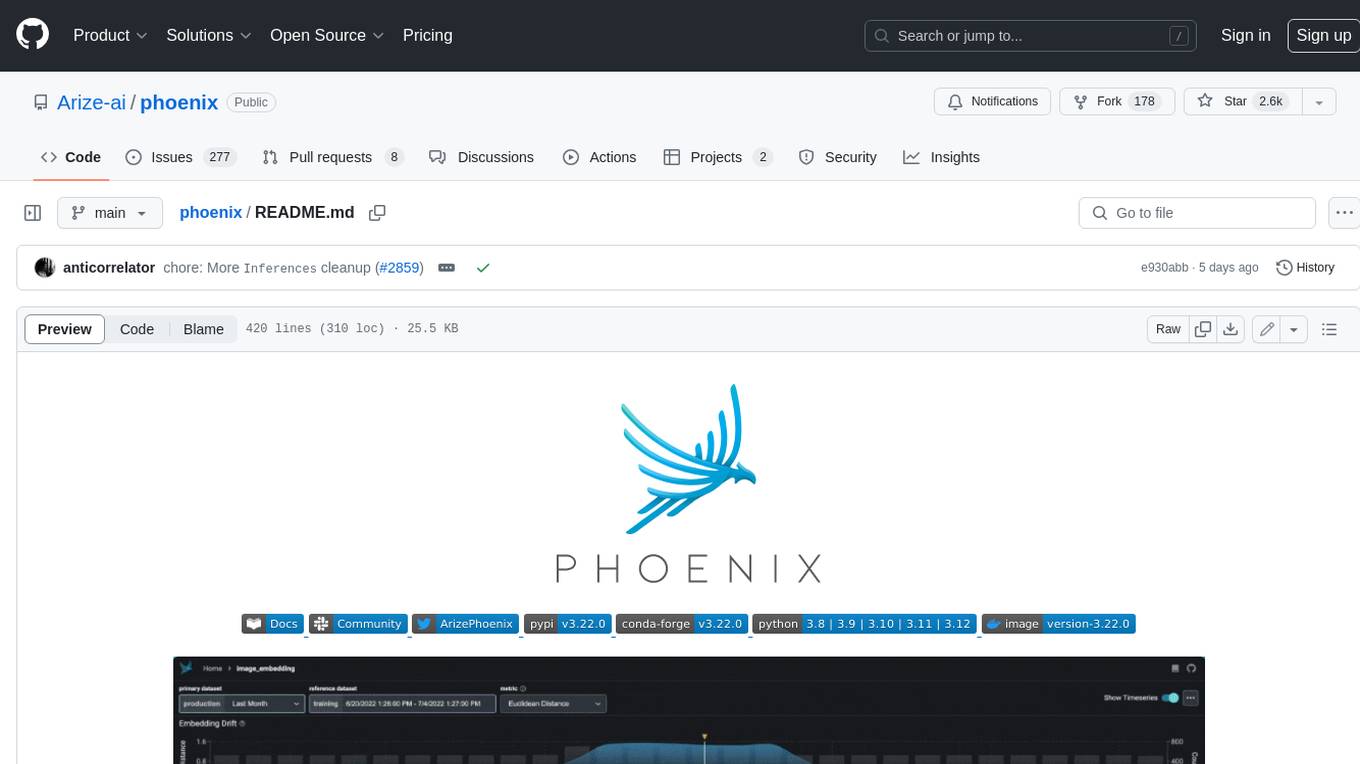
phoenix
Phoenix is a tool that provides MLOps and LLMOps insights at lightning speed with zero-config observability. It offers a notebook-first experience for monitoring models and LLM Applications by providing LLM Traces, LLM Evals, Embedding Analysis, RAG Analysis, and Structured Data Analysis. Users can trace through the execution of LLM Applications, evaluate generative models, explore embedding point-clouds, visualize generative application's search and retrieval process, and statistically analyze structured data. Phoenix is designed to help users troubleshoot problems related to retrieval, tool execution, relevance, toxicity, drift, and performance degradation.
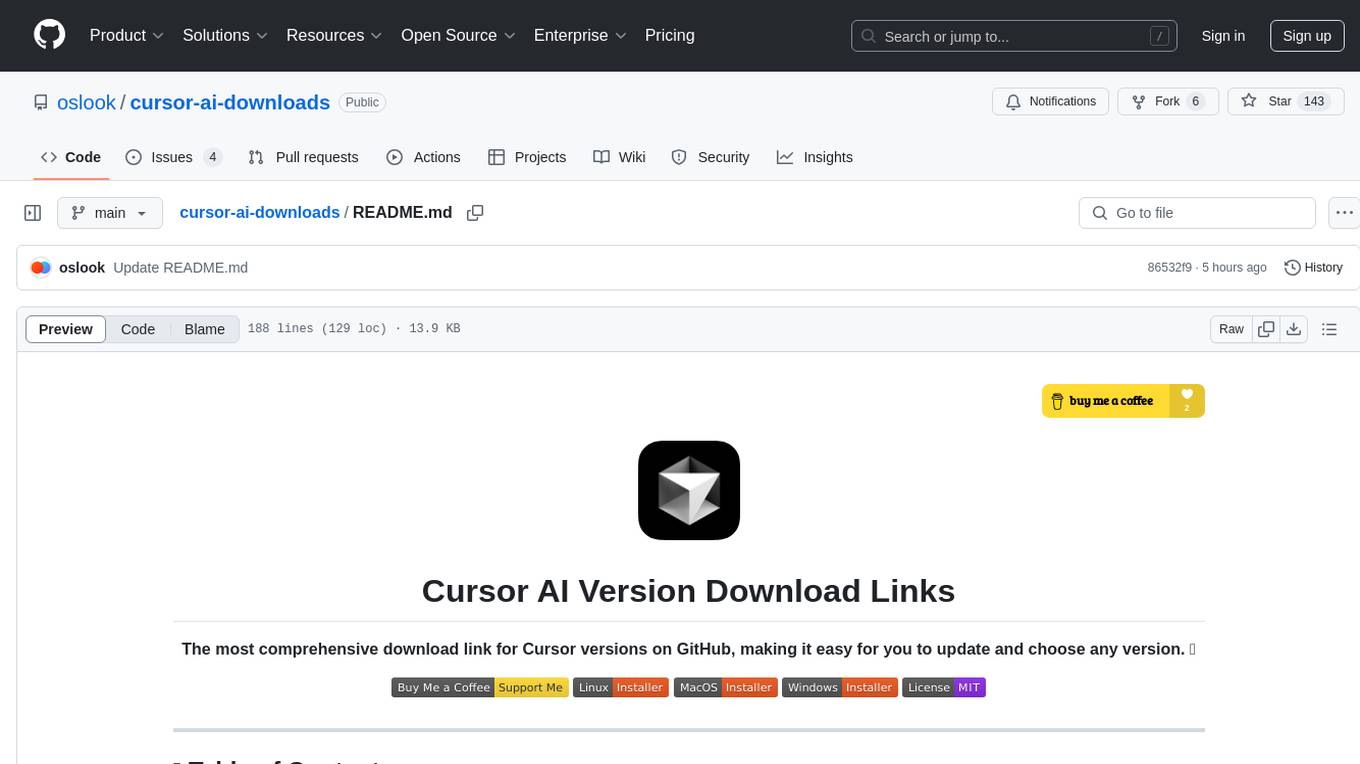
cursor-ai-downloads
Cursor AI Downloads is a GitHub repository that provides comprehensive download links for different versions of Cursor AI, an AI code editor designed to enhance productivity. Users can easily update and choose any version of Cursor AI, including older versions for a better user experience. The repository also includes information about Cursor AI features, changelog, and specific download links for Mac, Windows, and Linux platforms.
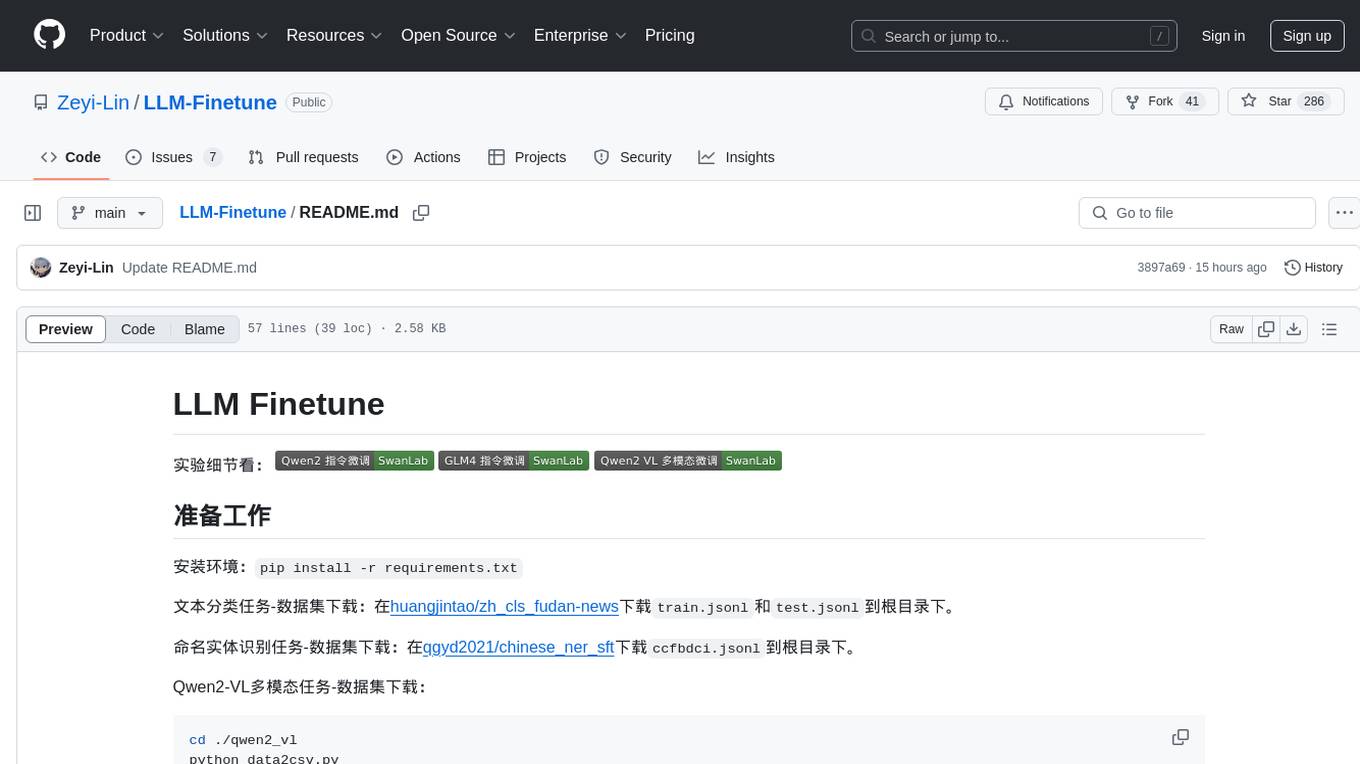
LLM-Finetune
LLM-Finetune is a repository for fine-tuning language models for various NLP tasks such as text classification and named entity recognition. It provides instructions and scripts for training and inference using models like Qwen2-VL and GLM4. The repository also includes datasets for tasks like text classification, named entity recognition, and multimodal tasks. Users can easily prepare the environment, download datasets, train models, and perform inference using the provided scripts and notebooks. Additionally, the repository references SwanLab, an AI training record, analysis, and visualization tool.
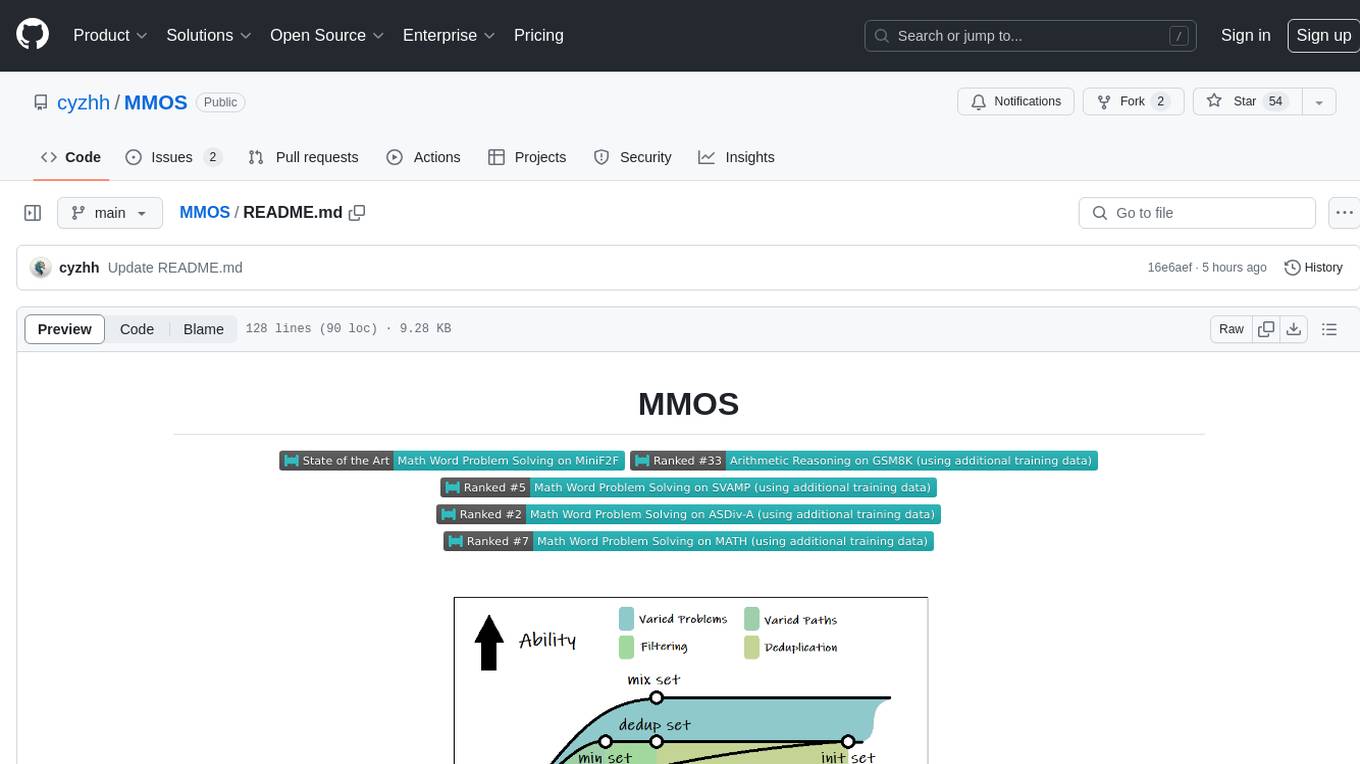
MMOS
MMOS (Mix of Minimal Optimal Sets) is a dataset designed for math reasoning tasks, offering higher performance and lower construction costs. It includes various models and data subsets for tasks like arithmetic reasoning and math word problem solving. The dataset is used to identify minimal optimal sets through reasoning paths and statistical analysis, with a focus on QA-pairs generated from open-source datasets. MMOS also provides an auto problem generator for testing model robustness and scripts for training and inference.
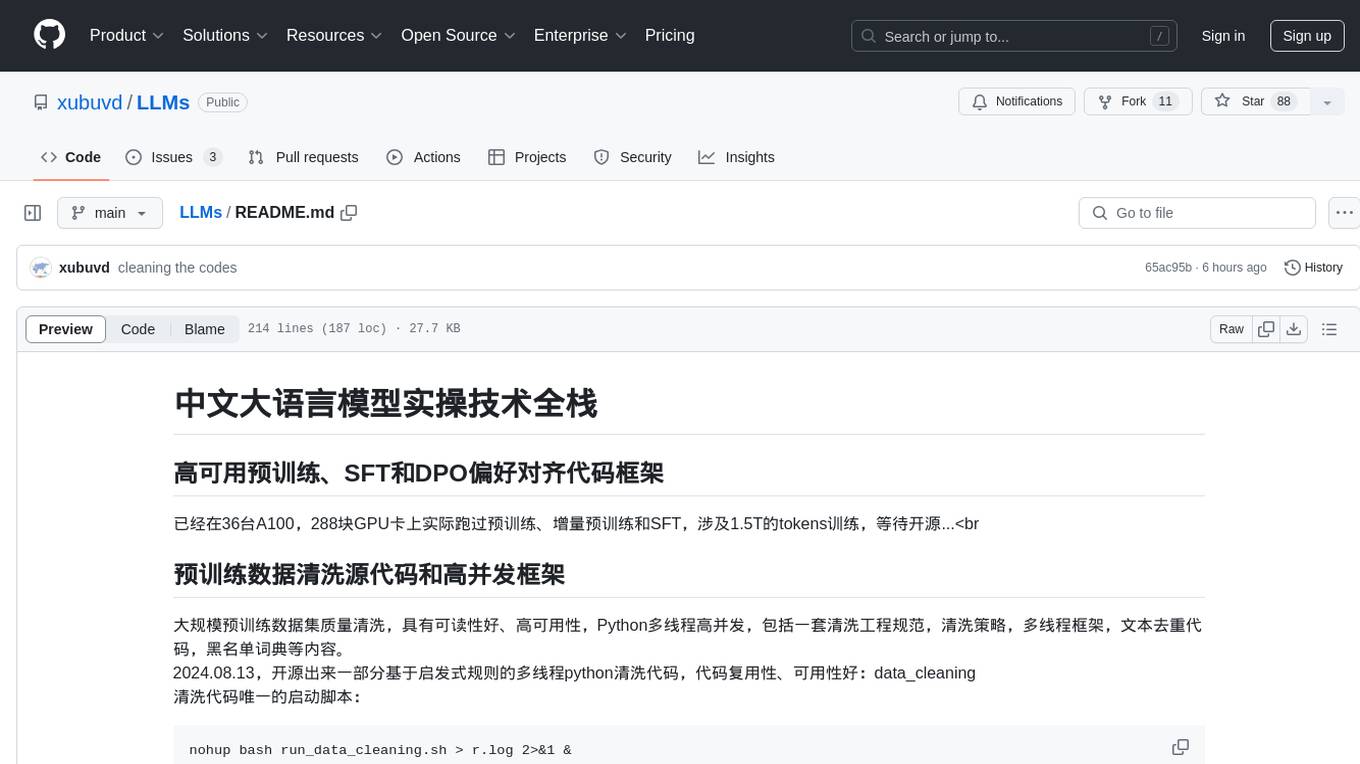
LLMs
LLMs is a Chinese large language model technology stack for practical use. It includes high-availability pre-training, SFT, and DPO preference alignment code framework. The repository covers pre-training data cleaning, high-concurrency framework, SFT dataset cleaning, data quality improvement, and security alignment work for Chinese large language models. It also provides open-source SFT dataset construction, pre-training from scratch, and various tools and frameworks for data cleaning, quality optimization, and task alignment.
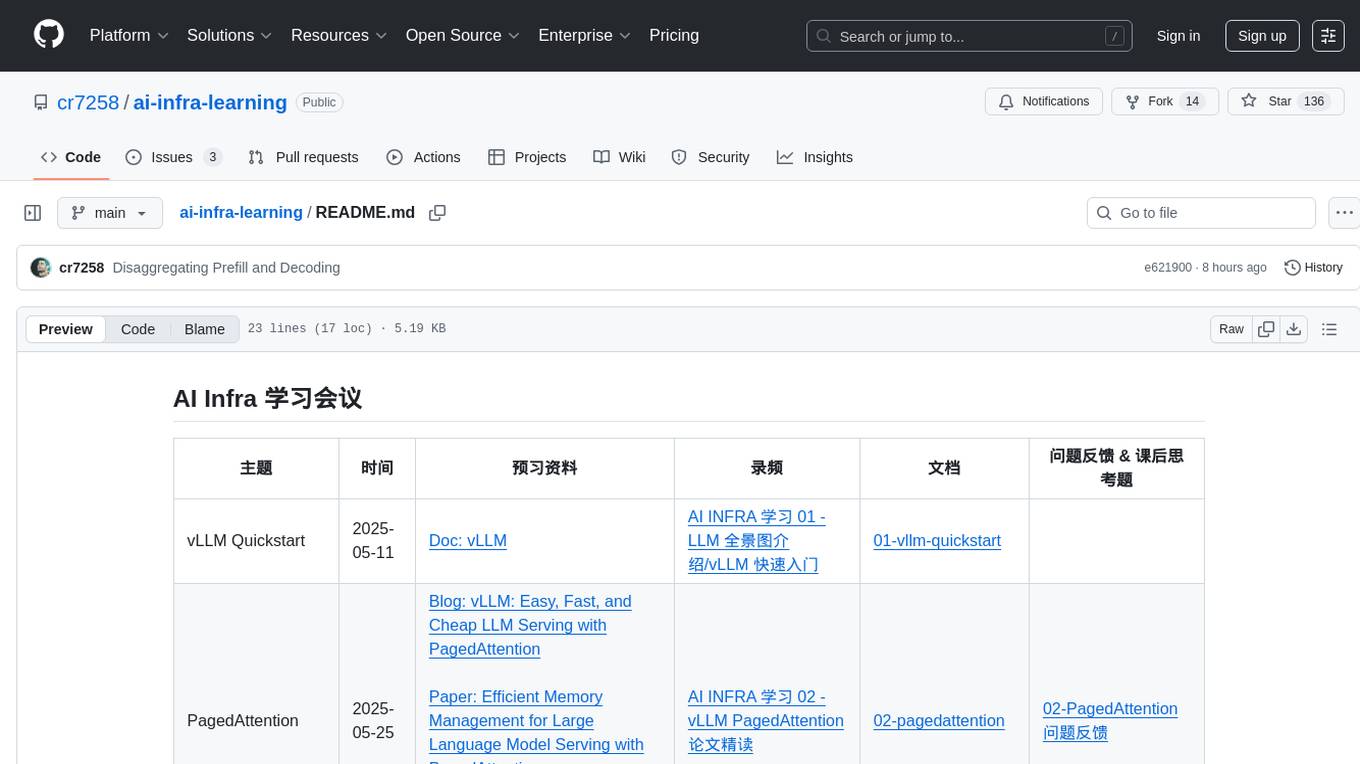
ai-infra-learning
AI Infra Learning is a repository focused on providing resources and materials for learning about various topics related to artificial intelligence infrastructure. The repository includes documentation, papers, videos, and blog posts covering different aspects of AI infrastructure, such as large language models, memory management, decoding techniques, and text generation. Users can access a wide range of materials to deepen their understanding of AI infrastructure and improve their skills in this field.
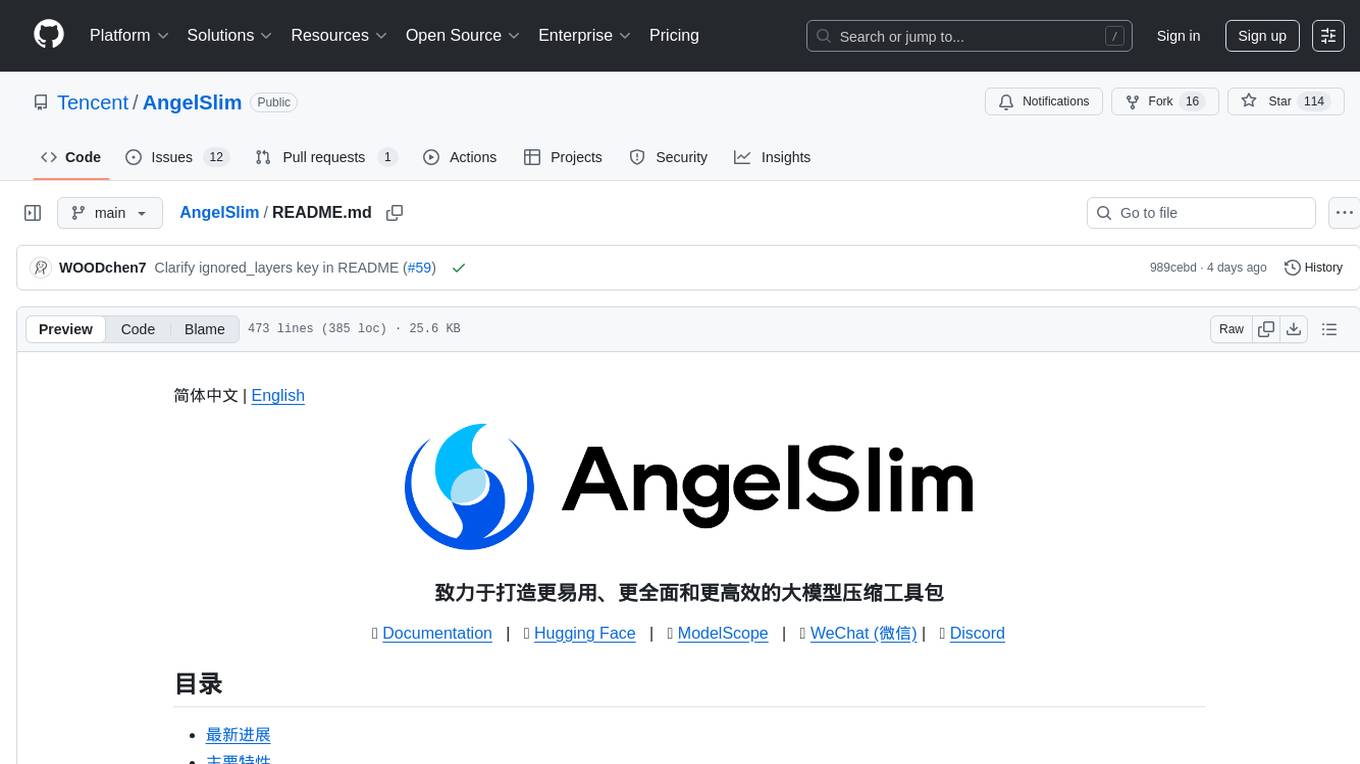
AngelSlim
AngelSlim is a comprehensive and efficient large model compression toolkit designed to be user-friendly. It integrates mainstream compression algorithms for easy one-click access, continuously innovates compression algorithms, and optimizes end-to-end performance in model compression and deployment. It supports various models for quantization and speculative sampling, with a focus on performance optimization and ease of use.
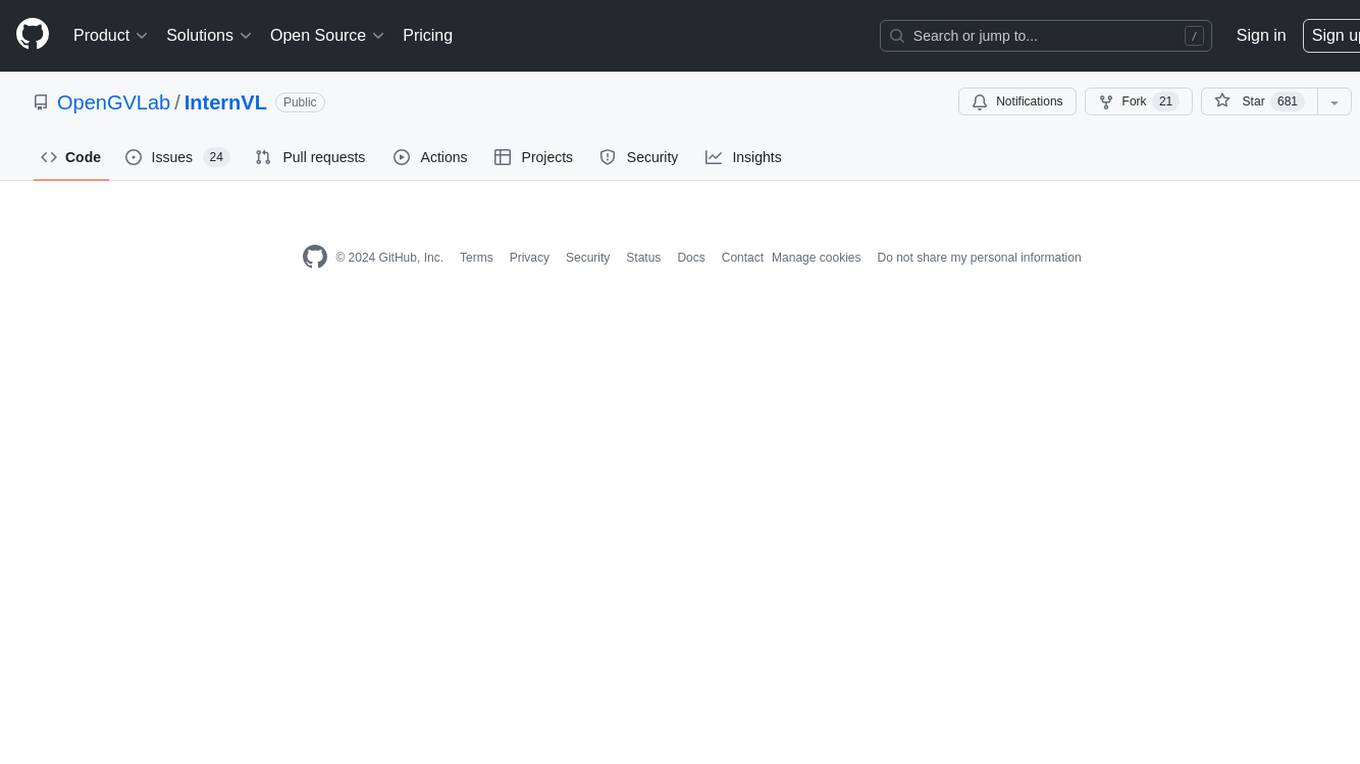
InternVL
InternVL scales up the ViT to _**6B parameters**_ and aligns it with LLM. It is a vision-language foundation model that can perform various tasks, including: **Visual Perception** - Linear-Probe Image Classification - Semantic Segmentation - Zero-Shot Image Classification - Multilingual Zero-Shot Image Classification - Zero-Shot Video Classification **Cross-Modal Retrieval** - English Zero-Shot Image-Text Retrieval - Chinese Zero-Shot Image-Text Retrieval - Multilingual Zero-Shot Image-Text Retrieval on XTD **Multimodal Dialogue** - Zero-Shot Image Captioning - Multimodal Benchmarks with Frozen LLM - Multimodal Benchmarks with Trainable LLM - Tiny LVLM InternVL has been shown to achieve state-of-the-art results on a variety of benchmarks. For example, on the MMMU image classification benchmark, InternVL achieves a top-1 accuracy of 51.6%, which is higher than GPT-4V and Gemini Pro. On the DocVQA question answering benchmark, InternVL achieves a score of 82.2%, which is also higher than GPT-4V and Gemini Pro. InternVL is open-sourced and available on Hugging Face. It can be used for a variety of applications, including image classification, object detection, semantic segmentation, image captioning, and question answering.
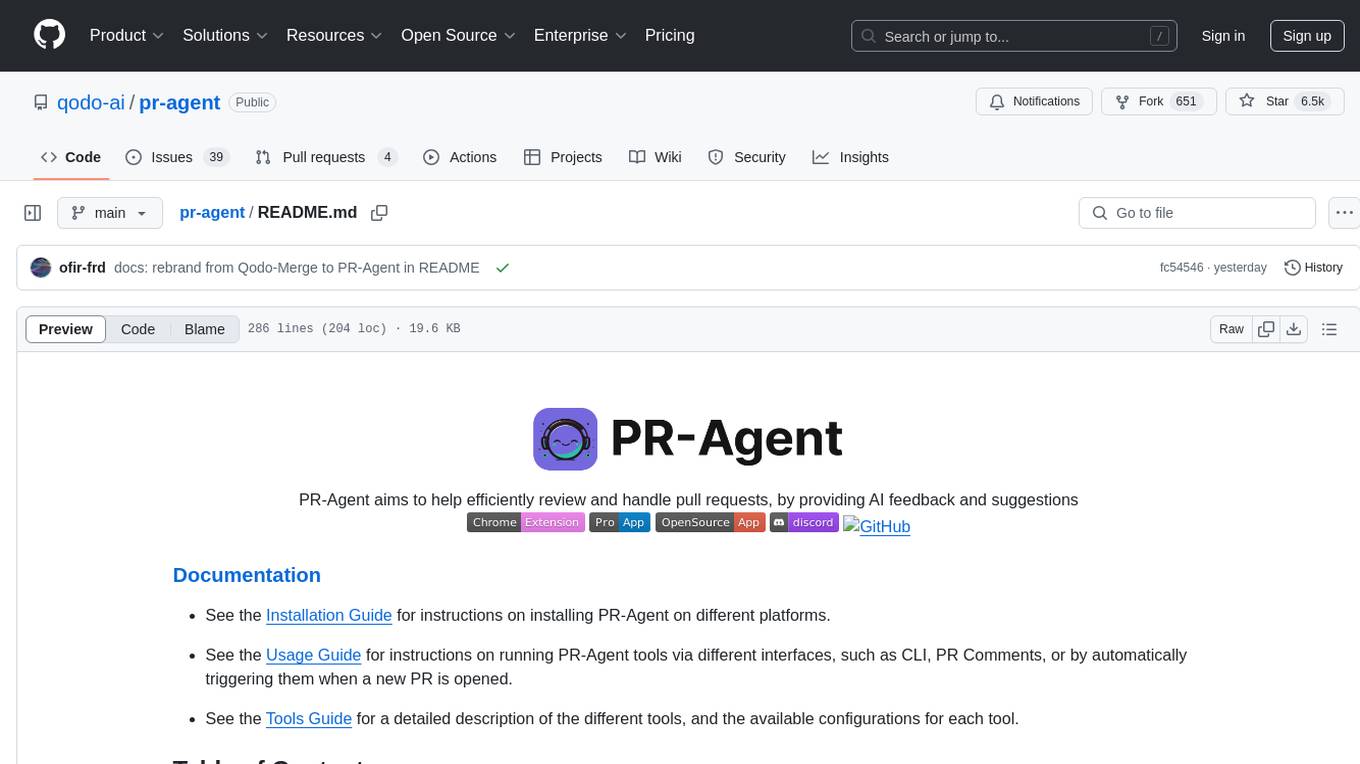
pr-agent
PR-Agent is a tool designed to assist in efficiently reviewing and handling pull requests by providing AI feedback and suggestions. It offers various tools such as Review, Describe, Improve, Ask, Update CHANGELOG, and more, with the ability to run them via different interfaces like CLI, PR Comments, or automatically triggering them when a new PR is opened. The tool supports multiple git platforms and models, emphasizing real-life practical usage and modular, customizable tools.
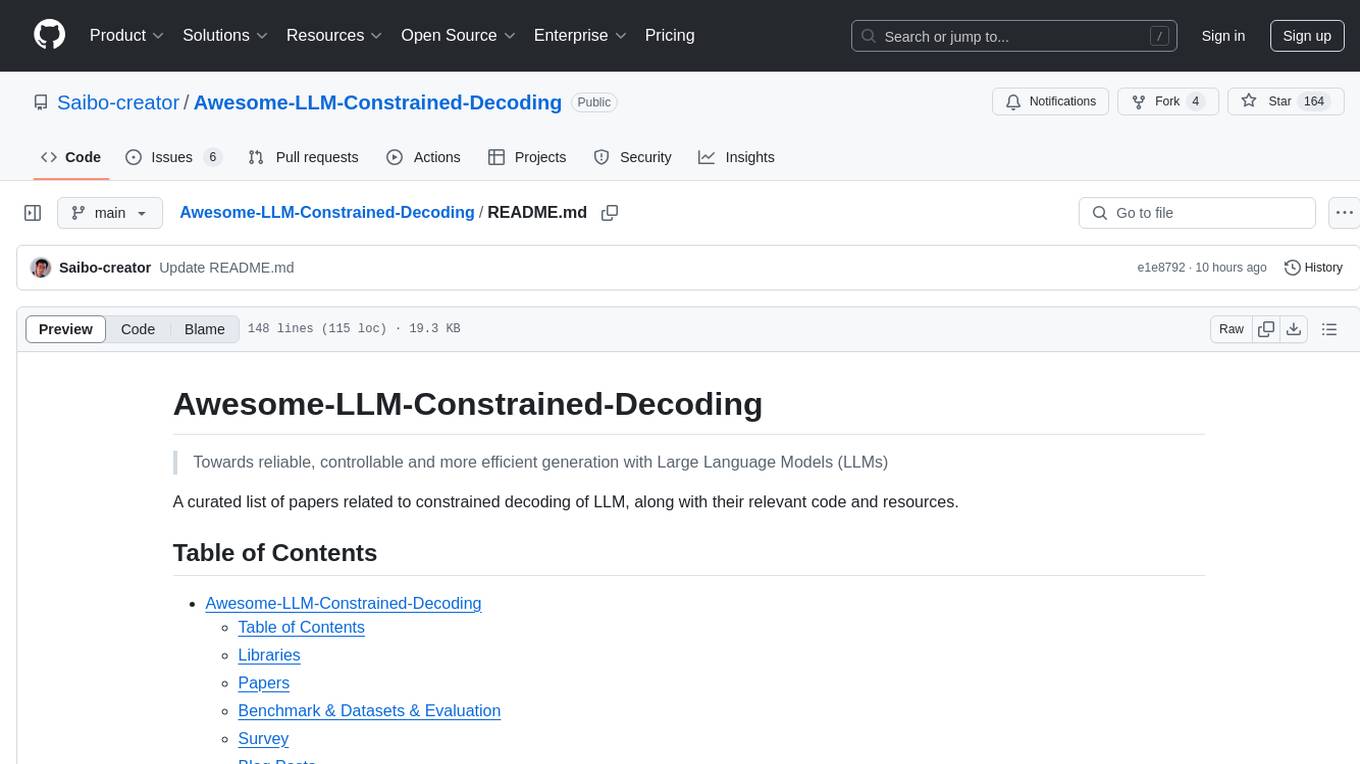
Awesome-LLM-Constrained-Decoding
Awesome-LLM-Constrained-Decoding is a curated list of papers, code, and resources related to constrained decoding of Large Language Models (LLMs). The repository aims to facilitate reliable, controllable, and efficient generation with LLMs by providing a comprehensive collection of materials in this domain.
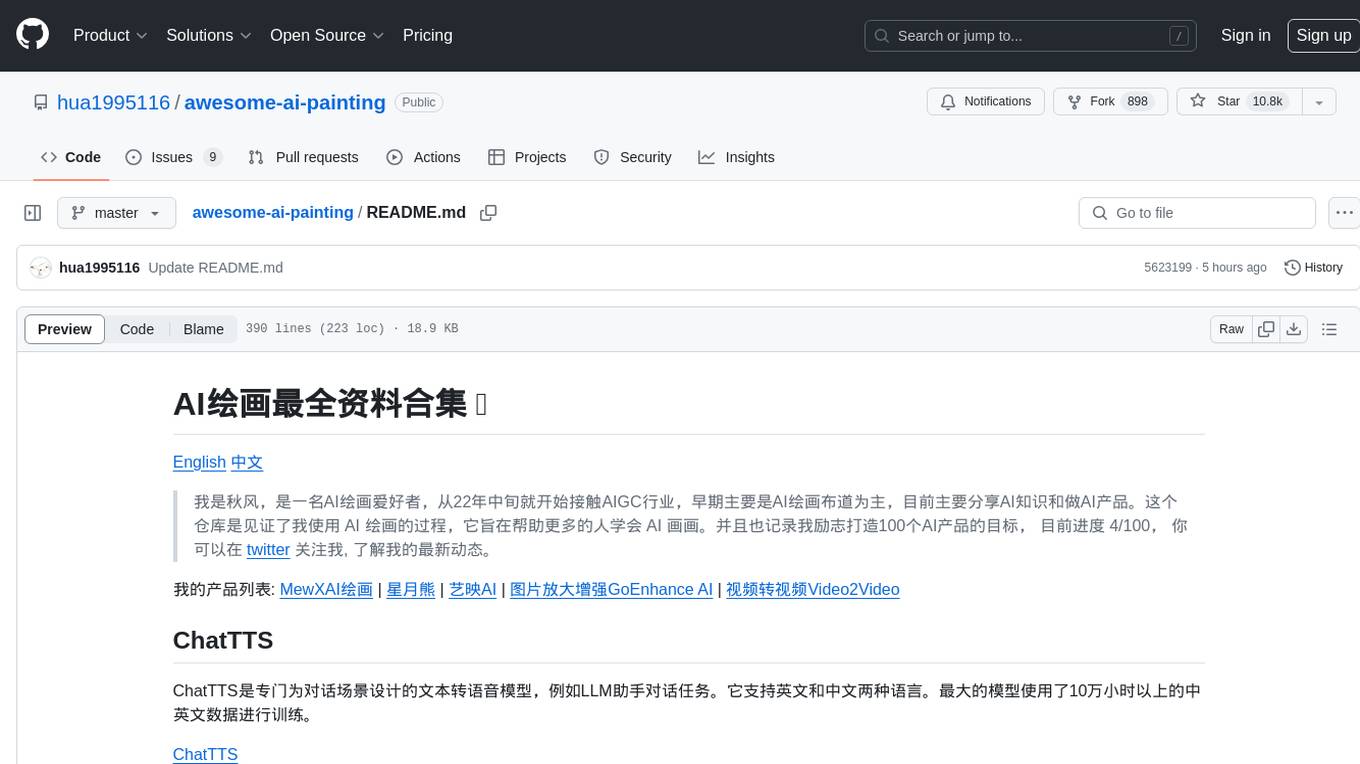
awesome-ai-painting
This repository, named 'awesome-ai-painting', is a comprehensive collection of resources related to AI painting. It is curated by a user named 秋风, who is an AI painting enthusiast with a background in the AIGC industry. The repository aims to help more people learn AI painting and also documents the user's goal of creating 100 AI products, with current progress at 4/100. The repository includes information on various AI painting products, tutorials, tools, and models, providing a valuable resource for individuals interested in AI painting and related technologies.
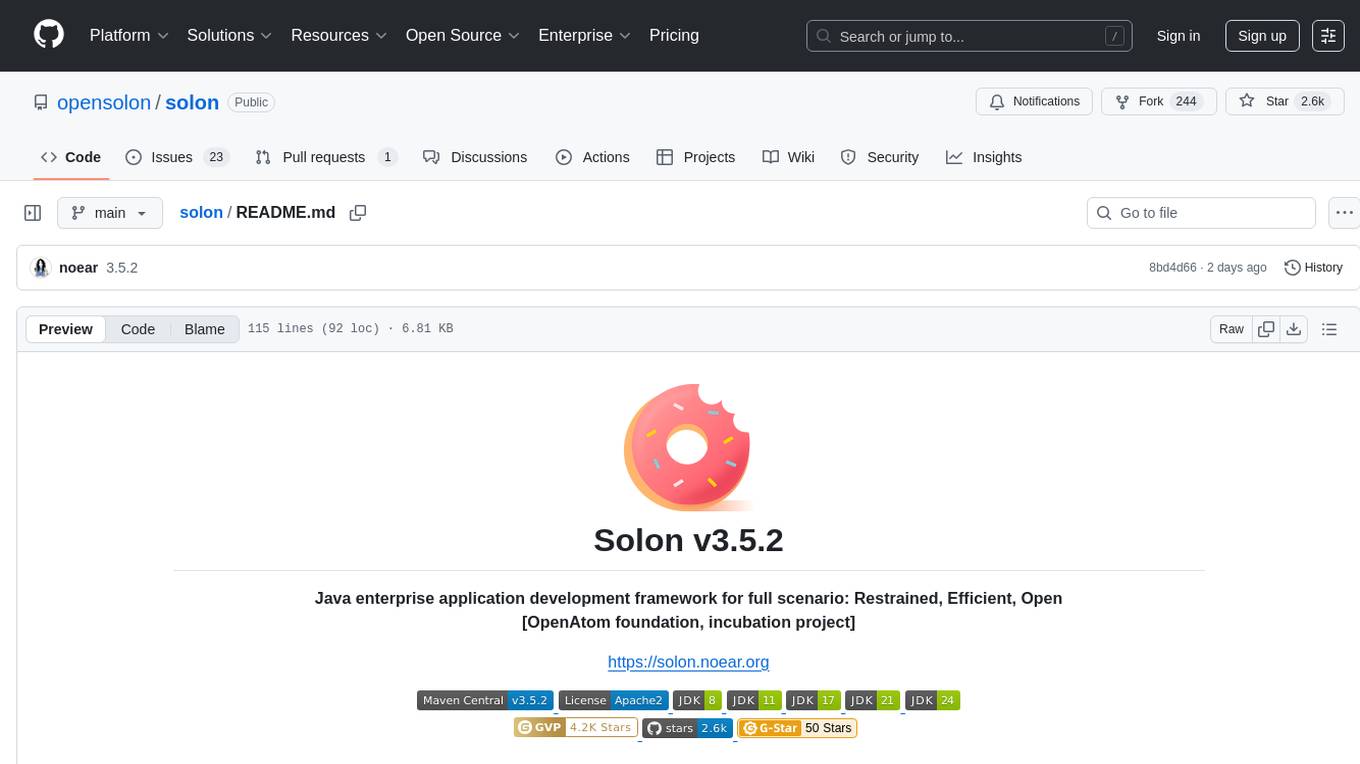
solon
Solon is a Java enterprise application development framework that is restrained, efficient, and open. It offers better cost performance for computing resources with 700% higher concurrency and 50% memory savings. It enables faster development productivity with less code and easy startup, 10 times faster than traditional methods. Solon provides a better production and deployment experience by packing applications 90% smaller. It supports a greater range of compatibility with non-Java-EE architecture and compatibility with Java 8 to Java 24, including GraalVM native image support. Solon is built from scratch with flexible interface specifications and an open ecosystem.
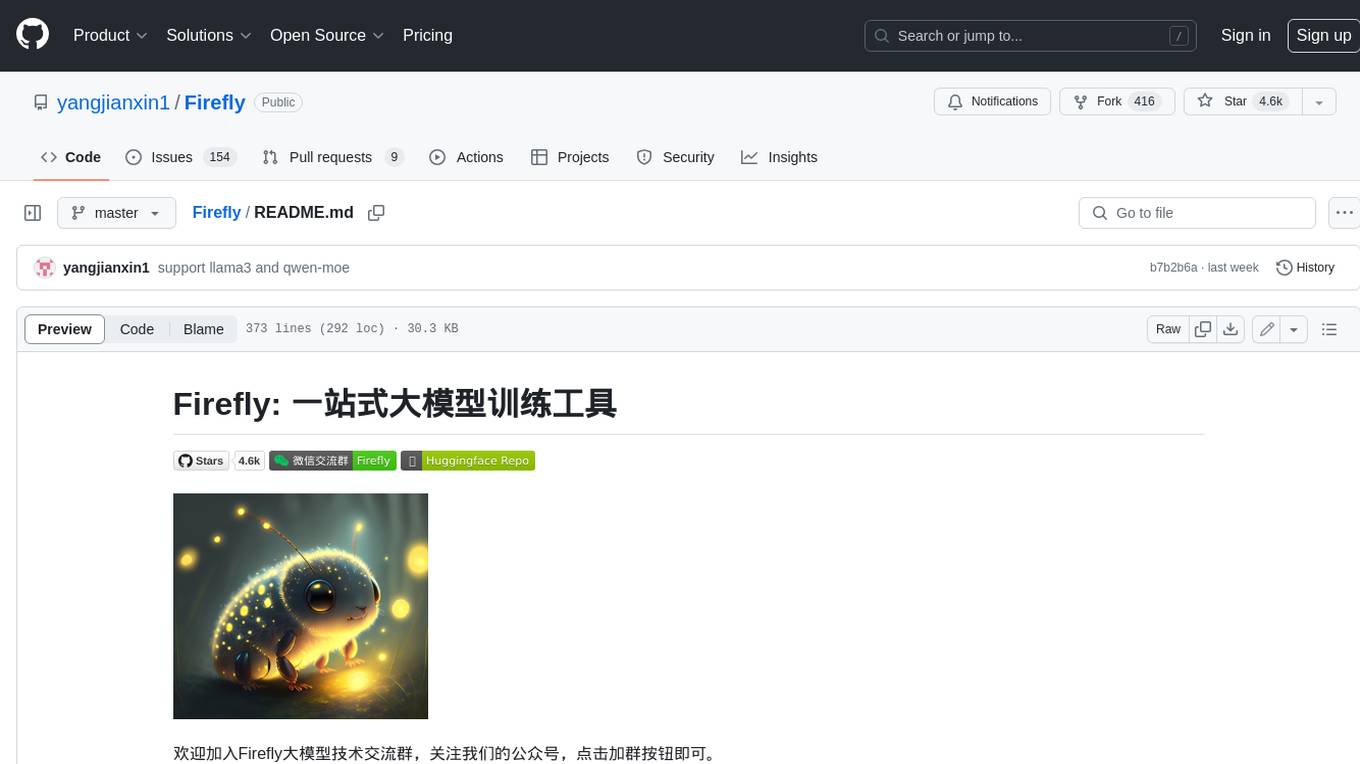
Firefly
Firefly is an open-source large model training project that supports pre-training, fine-tuning, and DPO of mainstream large models. It includes models like Llama3, Gemma, Qwen1.5, MiniCPM, Llama, InternLM, Baichuan, ChatGLM, Yi, Deepseek, Qwen, Orion, Ziya, Xverse, Mistral, Mixtral-8x7B, Zephyr, Vicuna, Bloom, etc. The project supports full-parameter training, LoRA, QLoRA efficient training, and various tasks such as pre-training, SFT, and DPO. Suitable for users with limited training resources, QLoRA is recommended for fine-tuning instructions. The project has achieved good results on the Open LLM Leaderboard with QLoRA training process validation. The latest version has significant updates and adaptations for different chat model templates.

LLM4SE
The collection is actively updated with the help of an internal literature search engine.
For similar tasks

LLMStack
LLMStack is a no-code platform for building generative AI agents, workflows, and chatbots. It allows users to connect their own data, internal tools, and GPT-powered models without any coding experience. LLMStack can be deployed to the cloud or on-premise and can be accessed via HTTP API or triggered from Slack or Discord.

ai-guide
This guide is dedicated to Large Language Models (LLMs) that you can run on your home computer. It assumes your PC is a lower-end, non-gaming setup.

onnxruntime-genai
ONNX Runtime Generative AI is a library that provides the generative AI loop for ONNX models, including inference with ONNX Runtime, logits processing, search and sampling, and KV cache management. Users can call a high level `generate()` method, or run each iteration of the model in a loop. It supports greedy/beam search and TopP, TopK sampling to generate token sequences, has built in logits processing like repetition penalties, and allows for easy custom scoring.

jupyter-ai
Jupyter AI connects generative AI with Jupyter notebooks. It provides a user-friendly and powerful way to explore generative AI models in notebooks and improve your productivity in JupyterLab and the Jupyter Notebook. Specifically, Jupyter AI offers: * An `%%ai` magic that turns the Jupyter notebook into a reproducible generative AI playground. This works anywhere the IPython kernel runs (JupyterLab, Jupyter Notebook, Google Colab, Kaggle, VSCode, etc.). * A native chat UI in JupyterLab that enables you to work with generative AI as a conversational assistant. * Support for a wide range of generative model providers, including AI21, Anthropic, AWS, Cohere, Gemini, Hugging Face, NVIDIA, and OpenAI. * Local model support through GPT4All, enabling use of generative AI models on consumer grade machines with ease and privacy.

khoj
Khoj is an open-source, personal AI assistant that extends your capabilities by creating always-available AI agents. You can share your notes and documents to extend your digital brain, and your AI agents have access to the internet, allowing you to incorporate real-time information. Khoj is accessible on Desktop, Emacs, Obsidian, Web, and Whatsapp, and you can share PDF, markdown, org-mode, notion files, and GitHub repositories. You'll get fast, accurate semantic search on top of your docs, and your agents can create deeply personal images and understand your speech. Khoj is self-hostable and always will be.

langchain_dart
LangChain.dart is a Dart port of the popular LangChain Python framework created by Harrison Chase. LangChain provides a set of ready-to-use components for working with language models and a standard interface for chaining them together to formulate more advanced use cases (e.g. chatbots, Q&A with RAG, agents, summarization, extraction, etc.). The components can be grouped into a few core modules: * **Model I/O:** LangChain offers a unified API for interacting with various LLM providers (e.g. OpenAI, Google, Mistral, Ollama, etc.), allowing developers to switch between them with ease. Additionally, it provides tools for managing model inputs (prompt templates and example selectors) and parsing the resulting model outputs (output parsers). * **Retrieval:** assists in loading user data (via document loaders), transforming it (with text splitters), extracting its meaning (using embedding models), storing (in vector stores) and retrieving it (through retrievers) so that it can be used to ground the model's responses (i.e. Retrieval-Augmented Generation or RAG). * **Agents:** "bots" that leverage LLMs to make informed decisions about which available tools (such as web search, calculators, database lookup, etc.) to use to accomplish the designated task. The different components can be composed together using the LangChain Expression Language (LCEL).

danswer
Danswer is an open-source Gen-AI Chat and Unified Search tool that connects to your company's docs, apps, and people. It provides a Chat interface and plugs into any LLM of your choice. Danswer can be deployed anywhere and for any scale - on a laptop, on-premise, or to cloud. Since you own the deployment, your user data and chats are fully in your own control. Danswer is MIT licensed and designed to be modular and easily extensible. The system also comes fully ready for production usage with user authentication, role management (admin/basic users), chat persistence, and a UI for configuring Personas (AI Assistants) and their Prompts. Danswer also serves as a Unified Search across all common workplace tools such as Slack, Google Drive, Confluence, etc. By combining LLMs and team specific knowledge, Danswer becomes a subject matter expert for the team. Imagine ChatGPT if it had access to your team's unique knowledge! It enables questions such as "A customer wants feature X, is this already supported?" or "Where's the pull request for feature Y?"

infinity
Infinity is an AI-native database designed for LLM applications, providing incredibly fast full-text and vector search capabilities. It supports a wide range of data types, including vectors, full-text, and structured data, and offers a fused search feature that combines multiple embeddings and full text. Infinity is easy to use, with an intuitive Python API and a single-binary architecture that simplifies deployment. It achieves high performance, with 0.1 milliseconds query latency on million-scale vector datasets and up to 15K QPS.
For similar jobs
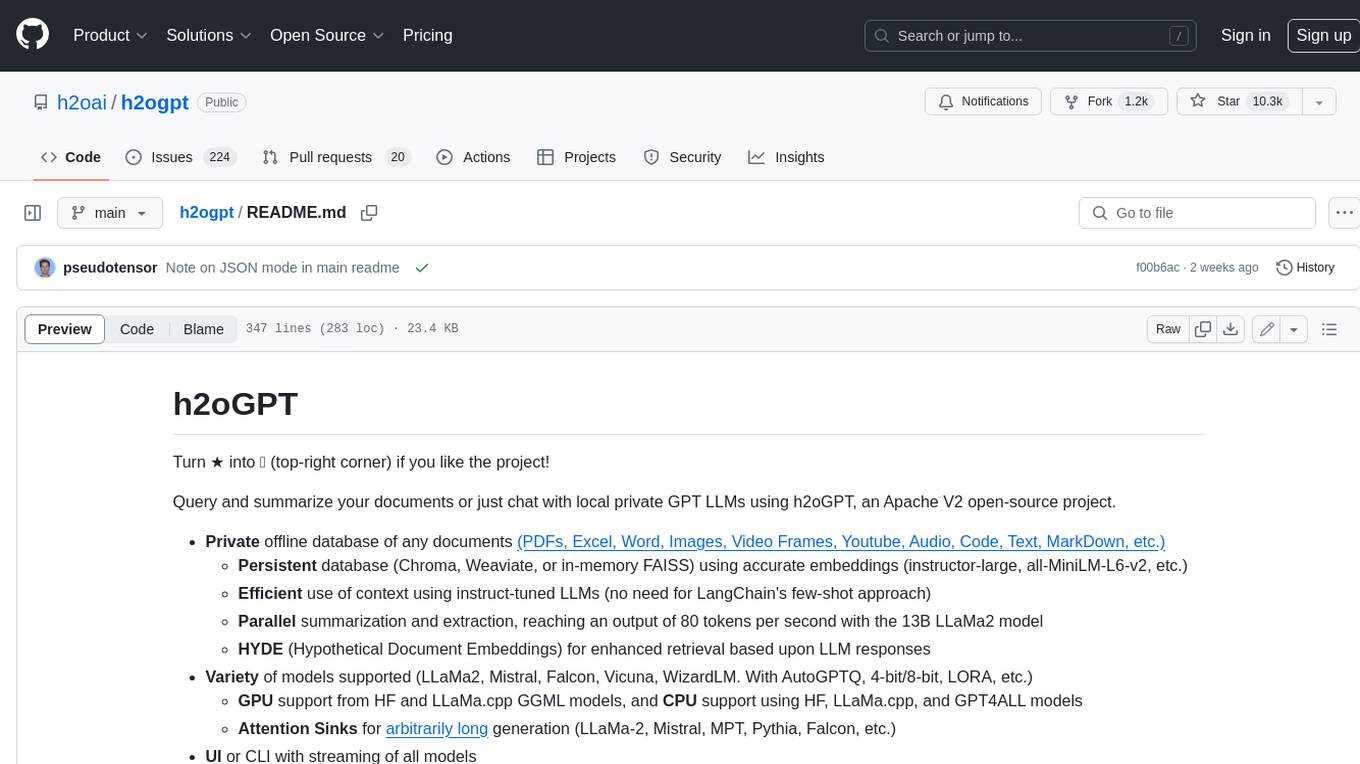
h2ogpt
h2oGPT is an Apache V2 open-source project that allows users to query and summarize documents or chat with local private GPT LLMs. It features a private offline database of any documents (PDFs, Excel, Word, Images, Video Frames, Youtube, Audio, Code, Text, MarkDown, etc.), a persistent database (Chroma, Weaviate, or in-memory FAISS) using accurate embeddings (instructor-large, all-MiniLM-L6-v2, etc.), and efficient use of context using instruct-tuned LLMs (no need for LangChain's few-shot approach). h2oGPT also offers parallel summarization and extraction, reaching an output of 80 tokens per second with the 13B LLaMa2 model, HYDE (Hypothetical Document Embeddings) for enhanced retrieval based upon LLM responses, a variety of models supported (LLaMa2, Mistral, Falcon, Vicuna, WizardLM. With AutoGPTQ, 4-bit/8-bit, LORA, etc.), GPU support from HF and LLaMa.cpp GGML models, and CPU support using HF, LLaMa.cpp, and GPT4ALL models. Additionally, h2oGPT provides Attention Sinks for arbitrarily long generation (LLaMa-2, Mistral, MPT, Pythia, Falcon, etc.), a UI or CLI with streaming of all models, the ability to upload and view documents through the UI (control multiple collaborative or personal collections), Vision Models LLaVa, Claude-3, Gemini-Pro-Vision, GPT-4-Vision, Image Generation Stable Diffusion (sdxl-turbo, sdxl) and PlaygroundAI (playv2), Voice STT using Whisper with streaming audio conversion, Voice TTS using MIT-Licensed Microsoft Speech T5 with multiple voices and Streaming audio conversion, Voice TTS using MPL2-Licensed TTS including Voice Cloning and Streaming audio conversion, AI Assistant Voice Control Mode for hands-free control of h2oGPT chat, Bake-off UI mode against many models at the same time, Easy Download of model artifacts and control over models like LLaMa.cpp through the UI, Authentication in the UI by user/password via Native or Google OAuth, State Preservation in the UI by user/password, Linux, Docker, macOS, and Windows support, Easy Windows Installer for Windows 10 64-bit (CPU/CUDA), Easy macOS Installer for macOS (CPU/M1/M2), Inference Servers support (oLLaMa, HF TGI server, vLLM, Gradio, ExLLaMa, Replicate, OpenAI, Azure OpenAI, Anthropic), OpenAI-compliant, Server Proxy API (h2oGPT acts as drop-in-replacement to OpenAI server), Python client API (to talk to Gradio server), JSON Mode with any model via code block extraction. Also supports MistralAI JSON mode, Claude-3 via function calling with strict Schema, OpenAI via JSON mode, and vLLM via guided_json with strict Schema, Web-Search integration with Chat and Document Q/A, Agents for Search, Document Q/A, Python Code, CSV frames (Experimental, best with OpenAI currently), Evaluate performance using reward models, and Quality maintained with over 1000 unit and integration tests taking over 4 GPU-hours.
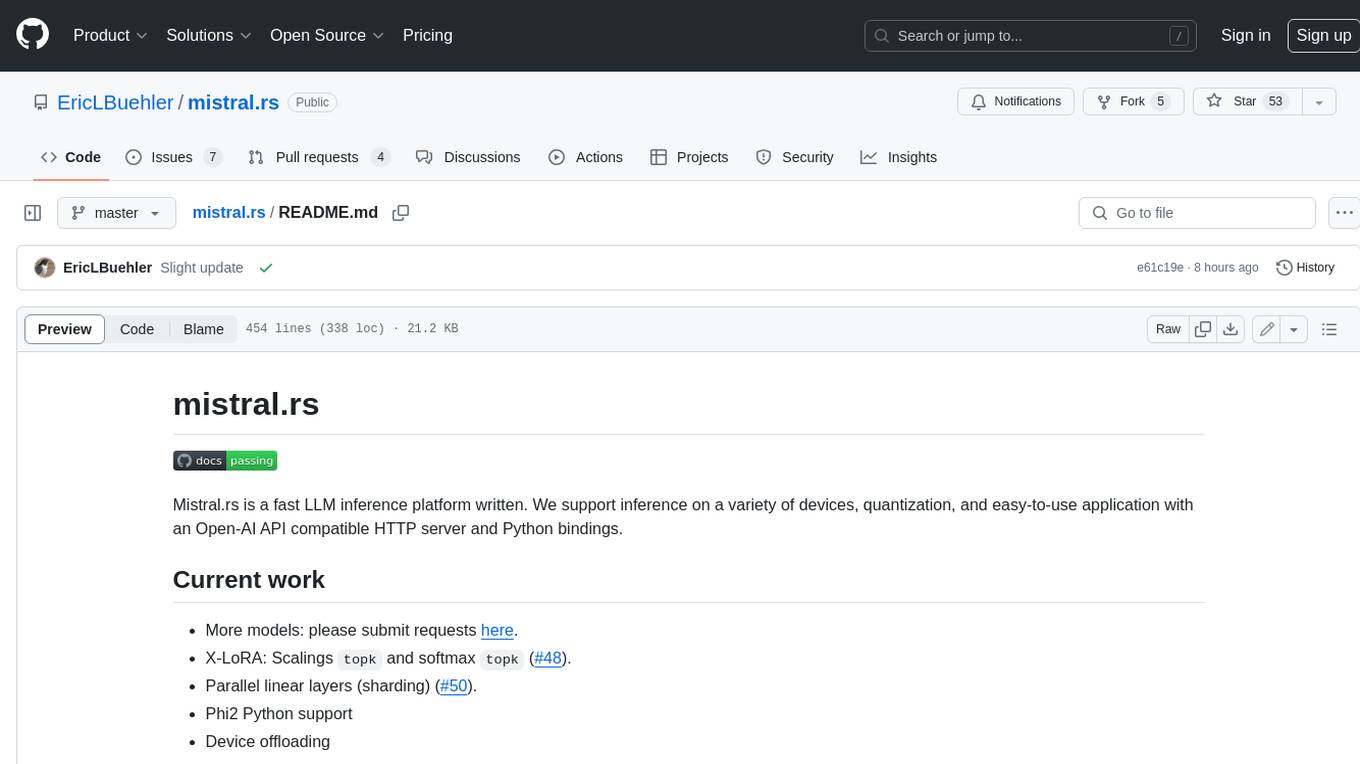
mistral.rs
Mistral.rs is a fast LLM inference platform written in Rust. We support inference on a variety of devices, quantization, and easy-to-use application with an Open-AI API compatible HTTP server and Python bindings.
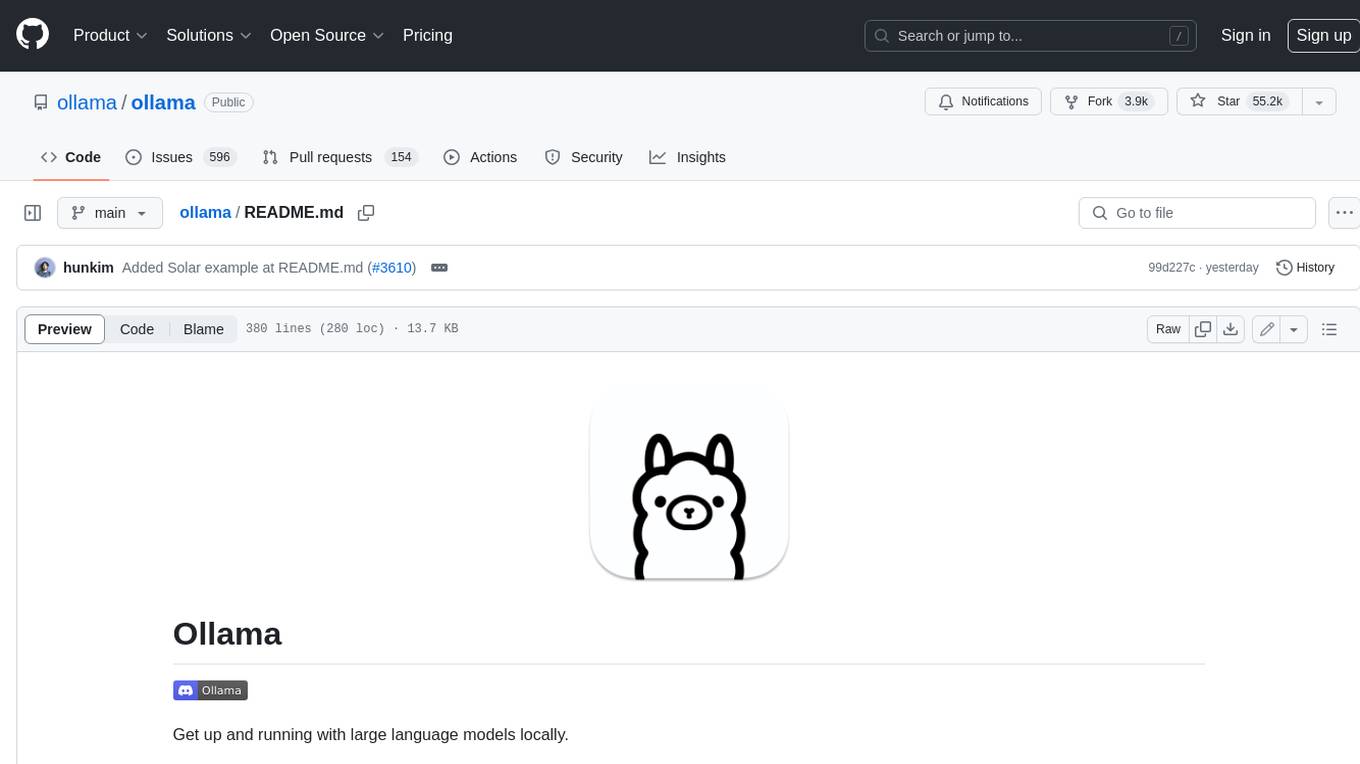
ollama
Ollama is a lightweight, extensible framework for building and running language models on the local machine. It provides a simple API for creating, running, and managing models, as well as a library of pre-built models that can be easily used in a variety of applications. Ollama is designed to be easy to use and accessible to developers of all levels. It is open source and available for free on GitHub.
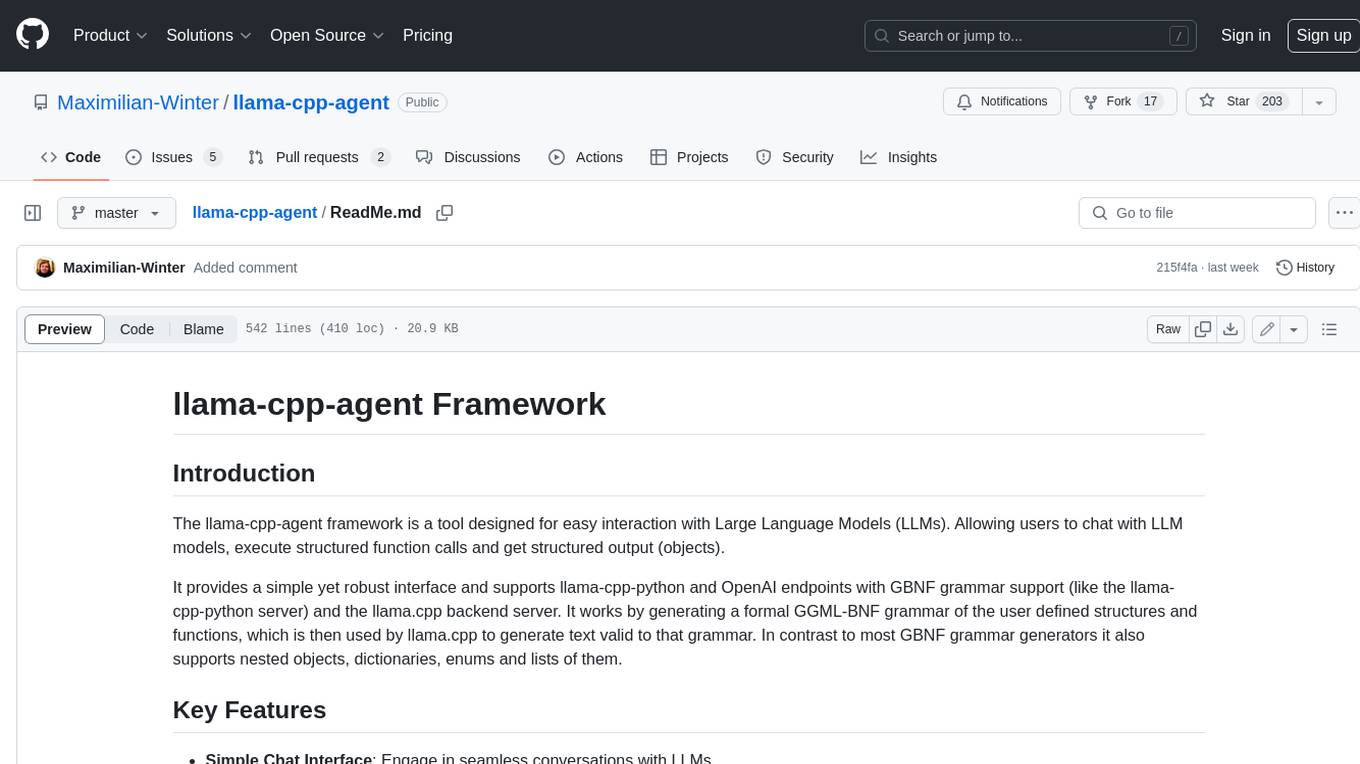
llama-cpp-agent
The llama-cpp-agent framework is a tool designed for easy interaction with Large Language Models (LLMs). Allowing users to chat with LLM models, execute structured function calls and get structured output (objects). It provides a simple yet robust interface and supports llama-cpp-python and OpenAI endpoints with GBNF grammar support (like the llama-cpp-python server) and the llama.cpp backend server. It works by generating a formal GGML-BNF grammar of the user defined structures and functions, which is then used by llama.cpp to generate text valid to that grammar. In contrast to most GBNF grammar generators it also supports nested objects, dictionaries, enums and lists of them.
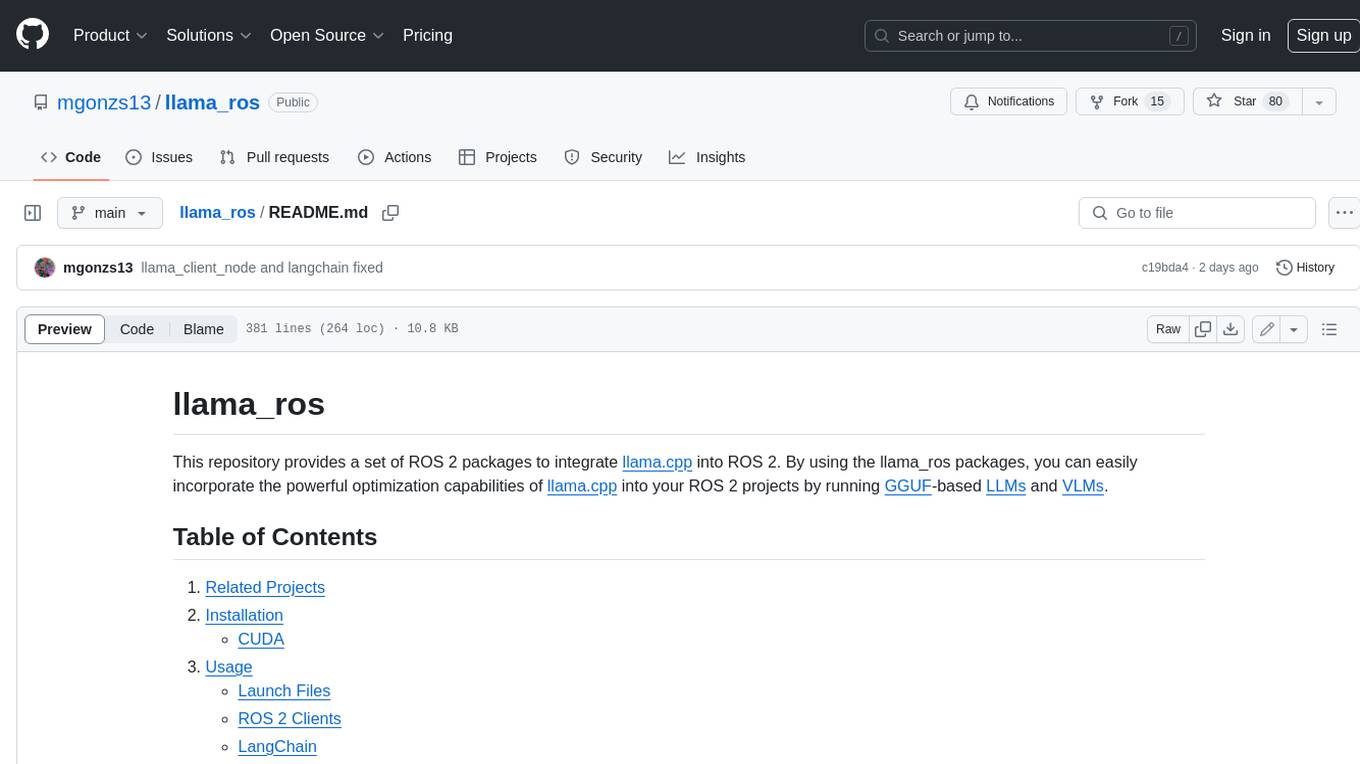
llama_ros
This repository provides a set of ROS 2 packages to integrate llama.cpp into ROS 2. By using the llama_ros packages, you can easily incorporate the powerful optimization capabilities of llama.cpp into your ROS 2 projects by running GGUF-based LLMs and VLMs.
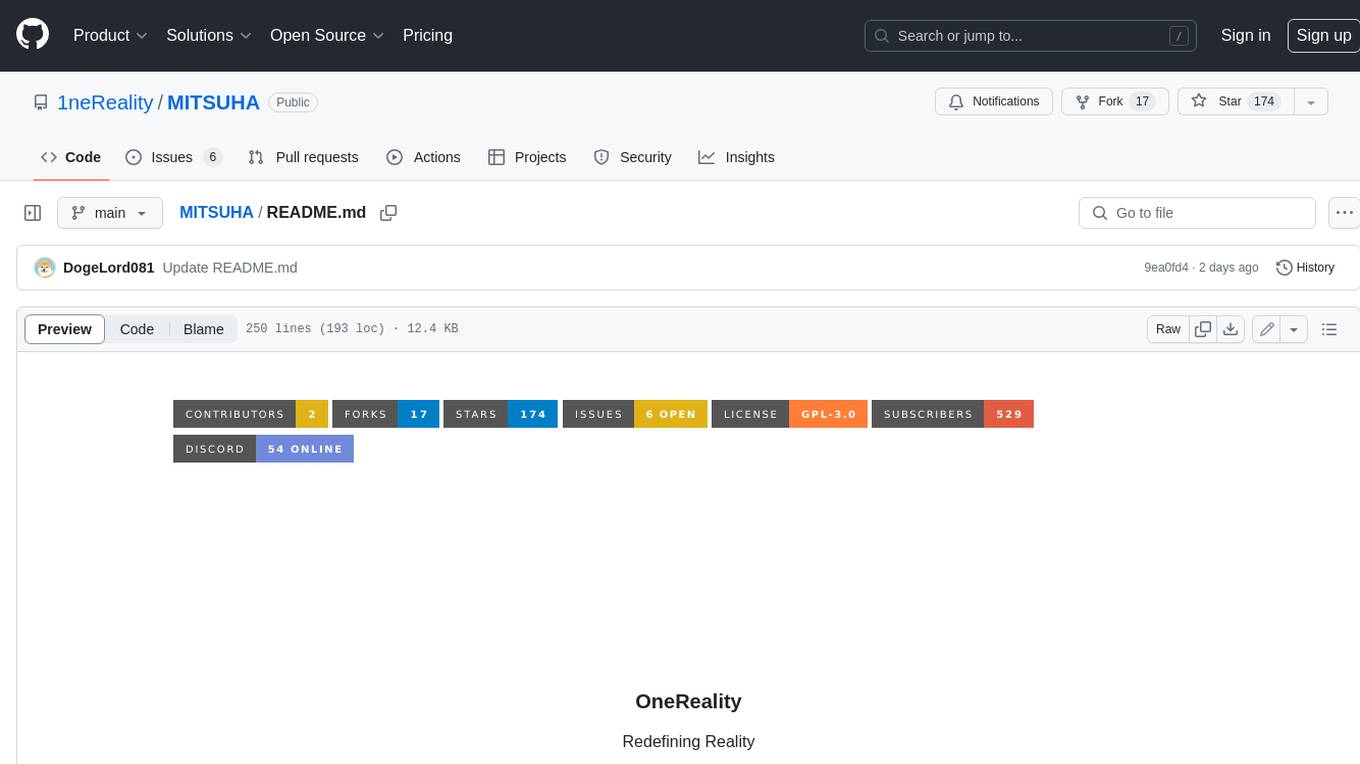
MITSUHA
OneReality is a virtual waifu/assistant that you can speak to through your mic and it'll speak back to you! It has many features such as: * You can speak to her with a mic * It can speak back to you * Has short-term memory and long-term memory * Can open apps * Smarter than you * Fluent in English, Japanese, Korean, and Chinese * Can control your smart home like Alexa if you set up Tuya (more info in Prerequisites) It is built with Python, Llama-cpp-python, Whisper, SpeechRecognition, PocketSphinx, VITS-fast-fine-tuning, VITS-simple-api, HyperDB, Sentence Transformers, and Tuya Cloud IoT.
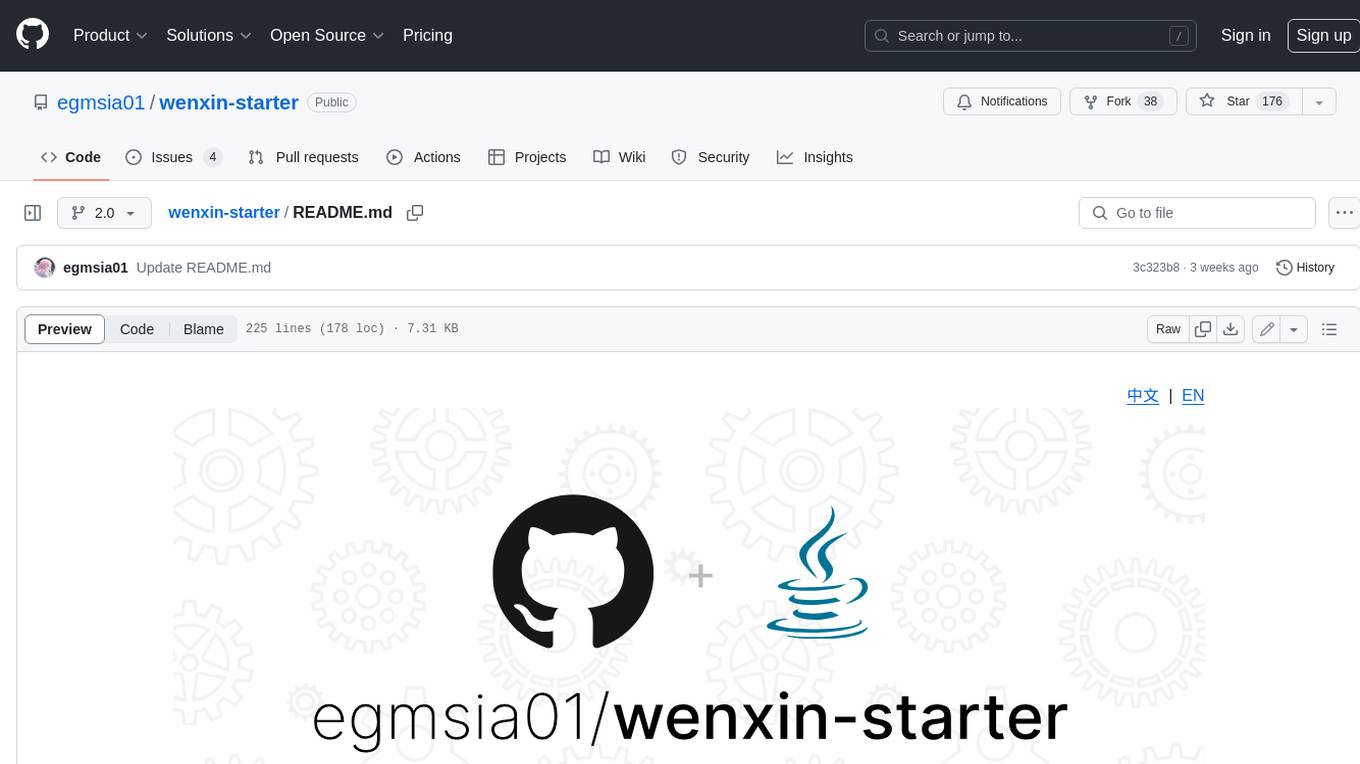
wenxin-starter
WenXin-Starter is a spring-boot-starter for Baidu's "Wenxin Qianfan WENXINWORKSHOP" large model, which can help you quickly access Baidu's AI capabilities. It fully integrates the official API documentation of Wenxin Qianfan. Supports text-to-image generation, built-in dialogue memory, and supports streaming return of dialogue. Supports QPS control of a single model and supports queuing mechanism. Plugins will be added soon.
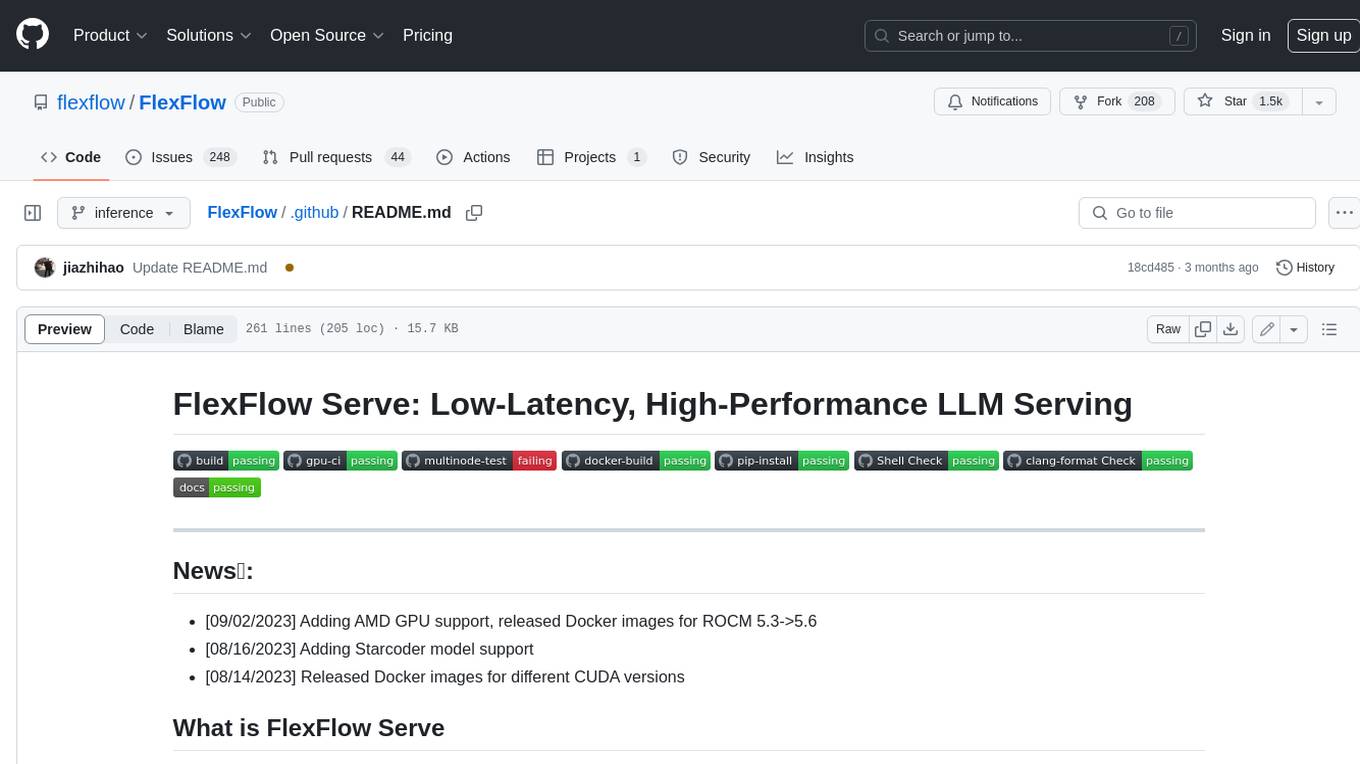
FlexFlow
FlexFlow Serve is an open-source compiler and distributed system for **low latency**, **high performance** LLM serving. FlexFlow Serve outperforms existing systems by 1.3-2.0x for single-node, multi-GPU inference and by 1.4-2.4x for multi-node, multi-GPU inference.










